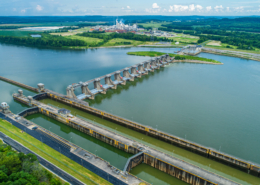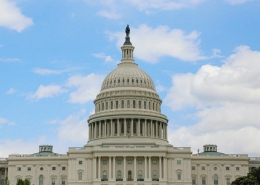This article is a part of our series From Lighthouses to Electric Chargers: A Presidential Series on Transportation Innovations
Martin Van Buren had a strong opinion about the federal government’s role in funding infrastructure projects (known at the time as “internal improvements.”) As a U.S. Senator from New York in the 1820s, Van Buren helped thwart President John Quincy Adams’ ambitious program of building new roads and canals.
As chair of the Senate Judiciary Committee, he questioned the legality of appropriating money for canals and roads. In fact, he introduced legislation to amend the Constitution so that Congress clearly had the authority to pay for them. He cited how two signers of the Constitution, former Presidents Jefferson and Madison, both thought the constitution would need to be amended, if the federal government wanted to fund canals and roads. Before Jefferson died, he warned that Congress was misinterpreting the Constitutional clauses relating to inter-state commerce and promotion of the general welfare to justify engaging in internal improvements.
After the federal government began surveying sites for potential roads and canals in the early 19th century, Congress was asked to fund an ever-increasing number of infrastructure projects. When Van Buren served on the Senate Finance Committee, he expressed his concerns about the impact this would have on the federal budget.
As secretary of state under President Andrew Jackson, he drafted the president’s veto of a bill that would have allowed the federal government to purchase stock in a private company building a 66-mile long road connecting Lexington with the Ohio River. It is not clear whether Van Buren’s main reason for opposing the bill was the cost, its potential unconstitutionality, or that it threatened the supremacy of the Erie Canal and New York’s prosperity. Van Buren’s home was near the Hudson River and he had served briefly as New York governor before President Jackson tapped him to be his secretary of state.
Jackson’s philosophy was similar to that of President Madison. They did not disparage the needs and question the benefits of every project, they just thought that the states and private interests, rather than the federal government, should be funding them.
As President
In his 1837 presidential inaugural address, Martin Van Buren boasted about how canals and steamships were connecting once inaccessible areas, leading to extraordinary changes in where people lived, how they worked, and what they consumed. He said, “new and inexhaustible sources of general prosperity have been opened; the effects of distance have been averted by the inventive genius of our people, developed and fostered by the spirit of our institutions; and the enlarged variety and amount of interests, productions, and pursuits have strengthened the chain of mutual dependence and formed a circle of mutual benefits too apparent ever to be overlooked.”
When he took office, however, Van Buren did not understand the depth of the nation’s economic problems he was facing. In a matter of weeks, beginning right before his inauguration in March 1837, the price of cotton fell by 25 percent. The American economy and many local governments, especially in the south, were heavily dependent on cotton. That was only one part of the economic problem.
Banks, foreign governments and businesses had been loaning large sums of money to U.S. businesses much of it related to canals, turnpikes, and railroads. Businesses had overextended themselves and the nation’s financial institutions were not robust enough to withstand an economic shock. When business owners rushed to their banks to withdraw funds, many of them came back empty handed. In 1837, nearly half of U.S. banks either partially or completely failed. The U.S. headed into a major depression with businesses going bankrupt and unemployment soaring.
Nearly a century later, during the Great Depression in the 1930s, President Franklin D. Roosevelt initiated a massive public works program to employ Americans and jump start the economy. That was not a consideration at Van Buren’s White House in the 1830s.
Van Buren made it clear at the outset of his administration that he intended to continue the policies of Andrew Jackson, his predecessor. According to the presidential scholar, Gleaves Whitney, “As for Federal aid to internal improvements, he cut off expenditures so completely that the Government even sold the tools it had used on public works.” That was a bit of an exaggeration since Van Buren did approve budgets that appropriated $1.5 million for river and harbor improvements as well as funding for a road in Ohio.
During Van Buren’s tenure, a fundamental change occurred at the state level because the “Panic of 1837” undermined confidence in public support for paying for infrastructure projects. While the federal government had only taken a limited role in building roads and canals, the states had been undertaking a massive program of internal improvements. Every state watched with envy at the financial and economic success of the Erie Canal. New York State had borrowed money to pay for its construction and that debt was paid off only twelve years after operations began in 1825.
Many states rushed to copy New York’s success. Virginia, Pennsylvania, Ohio, Indiana, and Illinois all funded canals of their own. A railroad building boom also began and states began investing in railroads (such as Maryland’s stake in the Baltimore and Ohio Railroad.) In 1841, because so many businesses were operating in the red and shut out of financing, eight different states defaulted on their canal and railway debt, leading to the abandonment of numerous construction projects.
The scale of the programs and the risk that states took was extraordinary. For example, Indiana’s state debt was $13.1 million, of which $9.5 million was associated with a planned system of interconnected canals, turnpikes, and railroads – little of which was ever completed.

(Historical marker of a portion of the canal that was built in Indianapolis. Source: Bedford)
In his book, America’s First Great Depression, Alasdair Roberts writes, “Humiliated by the experience of default or near-default, pressed by angry lenders, and oppressed by new taxes, states had abandoned the internal improvements movement. They had replaced their sunny views about popular sovereignty with a darker conception of the rationality of political processes. The economic crisis seemed to have taught them a lesson: that liberty without discipline was a formula for ruin.”
This article is a part of our series From Lighthouses to Electric Chargers: A Presidential Series on Transportation Innovations














